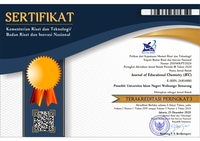Think-Pair-Square: A Collaborative Approach to Enhancing Critical Thinking Skills in Chemical Equilibrium
DOI:
https://doi.org/10.21580/jec.2025.7.1.28988Keywords:
critical thinking, chemical equilibrium, collaborative learning, think-pair-squareAbstract
Low levels of critical thinking skills among students on the topic of chemical equilibrium pose a significant challenge in chemistry education. This topic demands strong analytical, evaluative, and problem-solving abilities. This study aimed to investigate the effectiveness of the Think-Pair-Square (TPSq) learning model in enhancing students’ critical thinking skills. A pre-experimental one-group pretest–posttest design was employed, involving 59 students from two classes selected through cluster random sampling. Data were collected using a critical thinking skills test administered before and after the intervention, and analyzed using N-Gain and effect size. The results indicated a significant improvement in students’ critical thinking skills, with an average N-Gain of 0.48 (moderate category) and an effect size of 2.75 (very high category). These findings suggest that TPSq is an effective collaborative learning strategy for developing critical thinking skills in chemical equilibrium and can serve as an alternative instructional method that promotes student interaction and discussion.
Downloads
References
Affandy, H., Aminah, N. S., & Supriyanto, A. (2019). Analisis Keterampilan Berpikir Kritis Siswa pada Materi Fluida Dinamis di SMA Batik 2 Surakarta. Jurnal Materi dan Pembelajaran Fisika (JMPF), 9(1), 25. https://doi.org/10.37081/ed.v10i3.3849
Almubarak, M., & Rahmat. (2021). Tehnik Pemerikasaan dan Pengolahan Hasil Asesmen. Jurnal Pendidikan Islam, 4(1), 110–128. https://doi.org/10.32529/al-ilmi.v4i1.916
Amalia, W. N., Amir, H., & Sumpono. (2019). Studi Perbandingan Kemampuan Berpikir Kritis Siswa menggunakan Model Kooperatif Tipe Take And Give dan Think Pair Square di Kelas XI IPA SMA Negeri 1 Rejang Lebong. Jurnal Pendidikan dan Ilmu Kimia, 3(1), 8–14. https://doi.org/10.33369/atp.v3i1.9026
Antika, M. S., Andriani, L., & Revita, R. (2019). Pengaruh Penerapan Model Pembelajaran Kooperatif Tipe Think-Pair-Square Terhadap Kemampuan Pemahaman Konsep Matematis ditinjau dari Kemampuan Awal Matematika Siswa SMP. Journal for Research in Mathematics Learning) P, 2(2), 118–129.
Khairunnisa, K., Sari, F. F., Anggelena, M., Agustina, D., & Nursa’adah, E. (2022). Penggunaan Effect Size Sebagai Mediasi dalam Koreksi Efek Suatu Penelitian. Jurnal Pendidikan Matematika (Judika Education), 5(2), 138–151. https://doi.org/10.31539/judika.v5i2.4802
Kusuma, E. S. J., Handayani, A., & Rakhmawati, D. (2024). Pentingnya Pengembangan Kemampuan Berpikir Kritis pada Siswa Sekolah Dasar: Sebuah Tinjauan Literatur. Wawasan Pendidikan, 4(2), 369–379. 10.37081/mathedu.v4i2.2642
Putri, Z. R., & Jamaan, E. Z. (2023). Pengaruh Penerapan Model Kooperatif Tipe Think Pair Square terhadap Kemampuan Pemahaman Konsep Matematis Peserta Didik Kelas Viii SMPN 5 Mandau. Jurnal Edukasi dan Penelitian Matematika, 12(1), 190–194. http://dx.doi.org/10.24036/pmat.v12i1.14371
Zahira, S. G., & Nasution, M. L. (2023). Pengaruh Penerapan Model Pembelajaran Kooperatif Think Pair Square (TPSq) Terhadap Pemahaman Konsep Matematis Peserta Didik Kelas XI SMAN 12 Padang. Jurnal Edukasi dan Penelitian Matematika, 12(3), 263–267. http://dx.doi.org/10.24036/pmat.v12i3.15136
Published
How to Cite
Issue
Section
License
Copyright (c) 2025 Journal of Educational Chemistry (JEC)

This work is licensed under a Creative Commons Attribution-NonCommercial-ShareAlike 4.0 International License.
The copyright of the received article shall be assigned to the journal as the publisher of the journal. The intended copyright includes the right to publish the article in various forms (including reprints). The journal maintains the publishing rights to the published articles.
Authors are permitted to disseminate published articles by sharing the link/DOI of the article at the journal. Authors are allowed to use their articles for any legal purposes deemed necessary without written permission from the journal with an acknowledgment of initial publication to this journal.

This work is licensed under a Creative Commons Attribution-NonCommercial-ShareAlike 4.0 International License.


